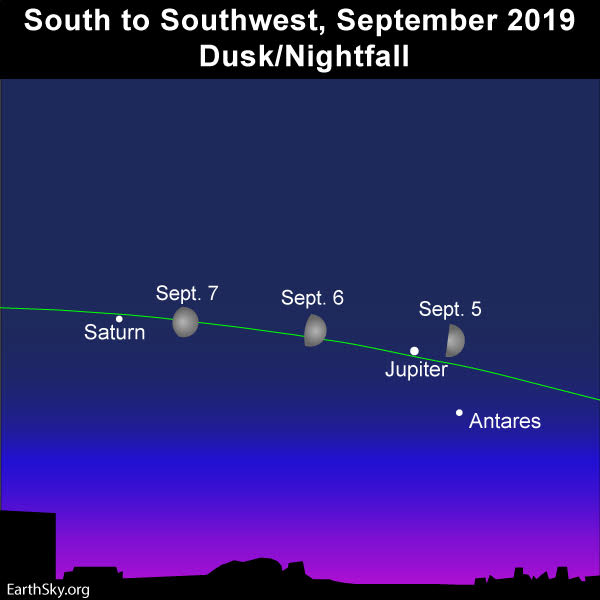September guide to the bright planets
Bruce McClure and Deborah Byrd in ASTRONOMY ESSENTIALS | September 1, 2019
There are only 2 planets easy to see in September 2019. Jupiter and Saturn can be found in the sky at nightfall and stay out until late night. Mercury and Venus are lost in the glow of sunset. Mars hides in the glare of sunrise.
Jupiter – the second-brightest planet after Venus – reigns supreme in the September 2019 night sky. That’s because Venus is sitting close to the glare of sunset all month, leaving dazzling Jupiter to rule the night. Jupiter pops out at dusk – brighter than any star – and stays out until late night. Not sure which one is Jupiter? See the moon in Jupiter’s vicinity for several days, centered on or near September 5. Or just look along the path the sun travels during the day – the ecliptic – for the brightest starlike object you can see. That’ll be Jupiter.
That bright, fiercely twinkling red star – close to Jupiter on our sky’s dome this year – is Antares, the Heart of the Scorpion in the constellation Scorpius. In 2019, sky watchers have been watching Jupiter “wander” east and west relative to this zodiac star. In the first three months of 2019, Jupiter was traveling eastward, away from Antares. Starting on April 10, 2019, Jupiter reversed course, and began moving toward Antares. For four months (April 10 to August 11, 2019), Jupiter traveled in retrograde (or westward), closing the gap between itself and this star. Jupiter is now moving eastward again, away from Antares.
Saturn. After you find Jupiter at dusk and nightfall, use this brilliant beauty of a planet to find another bright evening planet, Saturn. Saturn is not as bright as Jupiter, but the ringed planet shines on par with the sky’s brightest stars. Hold your fist at arm’s length. Saturn is roughly three fist-widths to the east of Jupiter. Because Saturn is the only bright-looking “star” to occupy this part of the sky, you’re not likely to mistake a bright star for Saturn.
 |
 |
|
|||||||||||
 |
 |
||||||||||||
|
|
|
|
|
|
|
||||||||
 |
|
|
|
|
|
 |
|||||||
|
|
|
|
|||||||||||
|
|
|||||||||||||
|
|
|
|
|
|
|
|
|
|
|
|
|
|
|
Results 1 to 1 of 1
-
09-01-2019, 12:34 PM #1
September guide to the bright planets
Beginner's Guide for Rocket, NFPS and IKS66...
http://iptvtalk.net/showthread.php?2...-you-should-do
Kodi Options for Rocket, NFPS and IKS66...
http://iptvtalk.net/forumdisplay.php?71-Kodi
Check the Announcement Section...
http://iptvtalk.net/forumdisplay.php...-Announcements
Similar Threads
-
September Equinox
By ilan in forum Maps to the StarsReplies: 0Last Post: 09-22-2019, 12:48 PM -
June guide to the bright planets
By ilan in forum Maps to the StarsReplies: 0Last Post: 06-08-2019, 12:33 PM -
Look on the bright side.....
By bwcbob in forum Jokes/Humor Forum in honor of bwcbobReplies: 0Last Post: 03-05-2019, 10:25 AM -
Moon and 3 planets before dawn
By ilan in forum Maps to the StarsReplies: 0Last Post: 02-26-2019, 01:29 PM -
September equinox
By ilan in forum Maps to the StarsReplies: 0Last Post: 09-22-2018, 12:10 PM









 Reply With Quote
Reply With Quote